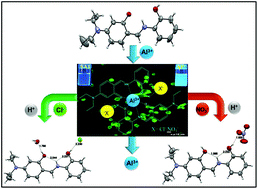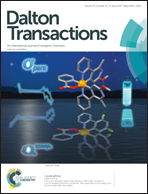A remarkable effect of N,N-diethylamino functionality on the optoelectronic properties of a salicylimine-based probe for Al3+†
Abstract
A new live-cell permeable, fluorescent probe comprised of a simple salicylimine-based Schiff base (SA1) has been developed for Al3+ with nano-molar sensitivity in aqueous media. SA1 was synthesized through a simple structural modification of a recently reported receptor SA2 by the incorporation of the N,N-diethylamino (DEA) group as a fine controllable unit. This modification affects the performance of SA1 remarkably in terms of its sensitivity, water compatibility and efficiency as well as its mechanistic aspect. The presence of the DEA group in SA1 led to its dual channel emission due to the TICT state and at the same time its hydrophobic nature was also responsible for controlling the strong hydration of Al3+ ions in aqueous media which ultimately led to the high sensitivity of SA1 for Al3+. The structure of SA1 was confirmed by single crystal X-ray diffraction and its binding with Al3+ was studied in detail using UV-visible, fluorescence and 1H NMR spectral studies along with mass determination. The effort of getting a single crystal of Al3+–SA1 led to single crystals of Cl−/NO3− complexes of protonated SA1 which were fully characterized by their XRD studies.


 Please wait while we load your content...
Please wait while we load your content...